There are various different types of driveline upgrades which will not only increase traction, but will also increase the ability to put down the power to the driven wheels. Ranging from clutches, propshafts/ driveshafts, through to limited slip differentials- as we add more power performance engine upgrades, careful consideration of the drivetrain is needed.
Drivetrain upgrades in high powered race and road cars, under go extreme stress and strains, especially when engines are modified from standard form. It is essential to try and build a firm and stable platform to maximise engine power delivery and also help to keep reliability in mind.
The by product of having increased engine power and more torque, over OEM equipment- is that sometimes the materials used in construction can not cope with that extra forces involved. Ways we can help negate these negative effects include using lighter and stronger materials which can not only increase performance , but also the longevity of the component for endurance.
These can not only help too increase strength of the component and its ability to keep structural rigidity under increased loads, but may also help increase the overall efficiency of the part in question. A carbon fibre driveshaft will not only be stronger and lighter- but due to the reduced mass will have less frictional loses involved- meaning less wasted power due to superior parts.
Clutch Upgrades
As we add more power to the engine, the drive line will increasingly become under more strain and stresses, under original operating specification equipment. Clutch upgrades are needed to compensate for the power increases, otherwise the actual engine BHP gains might not be seed at the driven wheels. Also durability and reliability will begin to become an issue if this extra engine power is used to its limits.
Lets get one thing clear, as there seems to be a lot of misinformation around this subject, clutch upgrades are not going to make more engine power. That is what engine upgrades do. What they will do is help transfer more engine horsepower and torque increases to the driven road wheels. As the clutch upgrade stages increase, they will be able to handle larger engine power increases, aid transmission loses, provide a more tactile feel to gear changes, higher strength levels.
1. Stage 1 Clutch
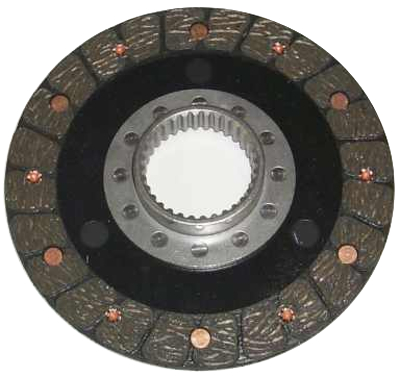
This is designed to match a OEM (original equipment manufacturer) standard clutch in terms of performance and drivability. Intended for standard performance vehicles with little or no performance gains or increased torque levels. Considered a like for like part exchange, with little to small performance gains. The feel of the clutch and progressive feel of the engagement may improve, also the unit will benefit from enhanced strength and durability depending on the manufacturer of the part. If you using the full capacity of the car´s power often, stage 1 clutch upgrades will need less mechanical care and maintenance than OEM equipment.
Improvements over worn out or damaged clutches can be made, especially if the current unit is slipping under loads. Viewed more as maintenance upgrade than purely a performance gain. It is always recommended to look at clutch conditions with any sizeable performance engine upgrade due to the increase torques and extra loads associated with them.
2. Stage 2 Clutch
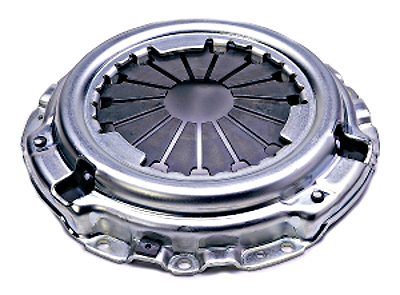
With increased clamping and horsepower/torque handling capabilities, normally a mild decrease in drivability compared respectively for everyday use in road driving. Intended for cars with basic to moderate engine tuning upgrades, these clutches will help maximise any power or performance increases made to the engine.
Standard equipment clutches may not be up to the job, due to the manufacture designing the original kit to meet a certain performance criteria. Increasing engine BHP/torque levels will need to be balanced in terms of drive line strain and stresses. Fitting stage 2 clutch upgrades will make sure the transfer of power from the engine is fully realised and inefficiencies in transmission loses kept to a minimum. All the advantages of stage 1 clutch upgrades in terms of strength and durability are included.
3. Stage 3 Clutch
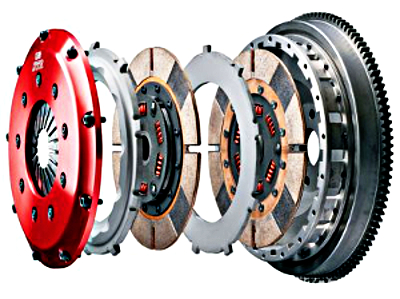
Engineered to provide higher levels of clamping force and BHP/torque handling capabilities. Without an uprated clutch with higher performance engines, all the power increases will not be able to be directly connected via the road driven wheels and create poor drive line efficiencies. The possibility of sub standard parts braking or wearing out too quickly is more likely. Creating a weak link in the performance package.
Created typically for auto racing and motorsport applications, where extreme heat conditions are generated due to the constant gear changes and huge forces/loads being applied through the systems. A range of exotic material are used and a F1 clutch for example, can be the size of your fists put together, but having the strength to with stand huge forces.
Due to the specialist application of motorsport products, just like tyres and sometimes brakes; these devices may need to reach optimum temperatures to get the best results. Ideally suited for the race tracks only due to the compromise in drivability. In everyday use these devices will not be a very smooth and a gentle application of the clutch, as they are designed for maximum performance with rapid shifting at high Rpm's. Smoothness and drivability are not top of the agenda for this upgrade, so careful application consideration needs to be in mind.
Lightened Flywheel
The flywheel is simple a device which is mounted on to the crankshaft, which helps to smooth out idling capacities. The flywheel is a direct connection to a car´s engine and it is part of the clutch assemble as well, as it is the clutch plate which makes contact with the flywheel. It effectively stores kinetic energy and trys to deliver a more linear torque delivery when the engine is not in its power phase of the OTTO cycle.
If a flywheel was not present, than we would get a big spike in torque, during the power phase and none present during the other stages (intake, compression and exhaust).
This is why road cars come with pretty large and heavy flywheels, to make an engine as smooth as possible, during idling at traffic lights or when in neutral.
The problem with large and heavy flywheels is that more energy is needed to be used to create inertia. This in turn reduces engine response and the ability of the engine to produce RPM´s (revolutions per minites). If we fit a lighter flywheel, we get a more responsive engine, with less of a deficit on engine power and the and the ability to rev higher and faster.
While standard flywheels have drivability and smoothness in mind, depending on your required goals-it is possible to fit lightweight units which will help the engine in the higher Rmp's. Depending on the exact application, this could result in reduced torque or the engine dropping Revs during gear changes, so a word of caution is needed. Get it right and you can gain, harder and faster acceleration due to the reduction in the units mass inertia. Resulting in a more rev hungry responsive engine, with quicker throttle response and sharper engine pick up during engine loads.
A downside of a lighter flywheel, will be reduced smoothness at idling or when in neutral gear, also engine Rev´s will drop more quickly, when off the throttle.
Limited Slip Differential/ LSD
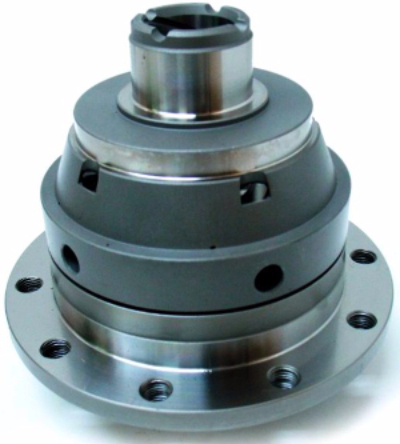
We have discussed the differential and the different types including the "Open" Differential and "Locked" Differential. Essentially we mentioned the Open differential was fitted to most road cars and that a Locked Differential acted like if none was not fitted.
We described how an Open Differential allowed the inside wheel when cornering to rotate at a different speed then the outside wheel, while allowing equal torque to be transmitted to both wheels. This is good for cornering and handling -as the outside wheel will be on a larger radius path then the inside wheel and a Differential can aid cornering performance. Also how a locked Differential could not do this, but had the advantage of being able to transmit varied amount of torque to independent wheels, much more suited to off road applications.
Limited-slip Differentials have the ability to have the best of both worlds.
But you may ask yourself why would I want to upgrade my differential if I have one already fitted. Well like most components in a car, they are a compromise especially in run of the mill production specifications.
Imagine this situation for a moment, we have a road car with a Open Differential fitted and one wheel is not in contact with the ground (not common in everyday situations) or stuck in mud and the other on solid ground for example. This could allow one wheel to rotate freely (the airborne wheel or one in mud) and the other to remain stationary as it could lack enough torque to gain traction. Remember the Open Differential is designed to split Torque equally between the two wheels. If one wheel does not have enough traction for grip, you are done 50% of available torque in a normal 2 wheel drive car.
In Motorsport, Rally, driving off road or even for high performance car applications; this is highly undesirable and this is why the differential over time has evolved to cope with these situations. By fitting a Limited Slip Differential -it can limited the "angular velocity" of the driven wheels and provide more torque to a driven wheel ( as long as there is traction available).
There Are 3 Types of Torque Inputs States During the LSD Functioning:
Load: coupling proportionate to torque input.
No Load: reduced to Static Coupling.
Over Run: when the LSD is on Over Run, this determines (during trailing throttle or in neutral gear in manuals) what type of behaviour the LSD undertakes.
When selecting a limited slip differential there are 1 Way, 1.5 Way and 2 way options available- with various uses for the desired application.
1 Way LSD
If there is no additional coupling on over run, the LSD is a 1 way type and essentially controls acceleration. A safer and more predictable LSD selection because as soon as the driver lifts the throttle (trailing throttle), the LSD unlocks and behaves somewhat like a conventional open differential. This is the preferred selection for for FF (front wheel drive cars) due to the fact it allows the car to turn in on throttle release. Especially important due to the fact FF cars are engineered to Understeer and fitting a 1 way LSD can help to combat these negative effects on Turn In.
1.5 Way LSD
Essentially the same as a 1 Way LSD which locks under acceleration, this type of differential also has some Coupling under deceleration. This can help out under hard braking and on corner exits and increases stability. You could view this as a balance between 1 and 2 Way types Limited Slip differentials.
2 Way LSD
This type of LSD has increased coupling in relation the Torque Inputs whether the direction is acceleration or deceleration and is classed as a 2 way differential. Drifters normally prefer this type as the LSD behaves the same way regardless of their erratic and aggressive throttle inputs. Also due the nature of the sport it allows the driven wheels to keep spinning all the way through a corner extending the Drift. An inexperienced driver can easily spin the car when using a 2 way LSD if they lift the throttle suddenly ( trailing throttle Oversteer), expecting the car to react like a conventional open differential set-up. Also some chassis and suspension tuning may need to be adapted to this LSD set up to counteract the extreme nature of it's characteristics.
There a commonly two different categories of LSD available Torque Sensitive (Clutch, Helical based and Cone based) and Speed Sensitive (Viscous, Pump and Clutch Pack).
1. Speed Sensitive LSD
Speed sensitive Limited Slip Differentials consists of Viscous, Pump and Clutch pack designs. The latter is gaining popularity especially in modern all-wheel drive vehicles, and generally requires less maintenance than the mechanical type.
Viscous Limited Slip Differential
Generally simpler in design then other types of LSD's because of the hydrodynamic friction from fluids with high viscosity. Silicone based oils are often used sealed with in a cylindrical chamber of fluid,with a stack of perforated discs that rotates with the normal motion of the output shafts. The inside surface of the chamber is coupled to one of the driveshafts and the outside coupled to the differential carrier.
Half of the discs are connected to the inner, the other half to the outer, alternating inner/outer in the stack. Differential motion forces the interleaved discs to move through the fluid against each other. In some viscous couplings when speed is maintained the fluid will accumulate heat due to friction. This heat will cause the fluid to expand, and expand the coupler causing the discs to be pulled together resulting in a non-viscous plate-to-plate friction and a dramatic drop in speed difference. This is known as the hump phenomenon and it allows the side of the coupler to gently lock. In contrast to the mechanical type, the limiting action is much softer and more proportional to the slip, and so is easier to cope with for the average driver.
Generally less effective then other designs, sudden lose of coupling can be experienced when the silicone oil is under constant use and heats up. It is widely known that constant hard use will slowly result in less and less performance with the LSD acting more and more like a Open design.
Pump Variant
This design works by hydraulically compressing a clutch pack together. The ge-rotor pump uses the housing to drive the outer side of the pump and the other axle shaft to drive the other one. When there is differential wheel rotation, the pump pressurizes its working fluid into the clutch pack area. This provides a clamp load for frictional resistance to transfer torque to the higher traction wheel. The pump based systems have a lower and upper limits on applied pressure, and internal damping to avoid hysteresis. The newest ge-rotor pump based system has computer regulated output for more versatility and no oscillation.
Clutch Pack Limited Slip Differential
Electronic limited slip differential systems use speed sensors, anti-lock braking system (ABS) sensors, accelerometers, and microcomputers to electronically monitor wheel slip and vehicle motion. In some systems the computer limits slip by varying the degree of locking in a mechanical LSD; such as Porsche's PSD system, which uses electro-hydraulic control of a mechanical LSD.
In other systems the computer uses the ABS system to control the slipping as follows. If either of the wheels on an axle is rotating unusually faster than the other, the computer will determine by how much it is slipping and will apply braking to it, slowing the spinning wheel down and causing the opposite wheels to gain speed and keep traction. One advantage of this system over mechanical LSD is that the vehicle steering and control is less affected.
It also generates less stress on the drive train compared to a mechanical locking device, making it particularly suitable for vehicles with independent suspension. It can also be tuned for specific applications on and off road and at different speeds. A disadvantage is that it is less predictable when going over an obstacle, as the system needs time to react. Also, the wheel with traction will only have half of the available torque applied to it.
The Mitsubishi Active Yaw Control (AYC) electronically controlled rear differential uses a conventional open differential with an added planetary gear set to rotate two hollow shafts around the left hand drive shaft, one running at +15% speed, one at -15%. These can be progressively locked up to the left hand drive shaft via a hydraulic clutch pack under CPU control, increasing or decreasing the torque on that wheel in relation to the other. This allows a certain amount of rear wheel "steering" to provide stability control and performs the function of an LSD.
2. Torque Sensitive LSD
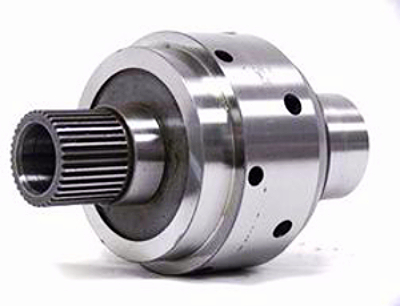
This type of LSD operates in a mechanical fashion by interaction between two or more moving parts. Under this category you will find Clutch, Geared and Cone type designs. Compared to a traditional Open LSD design, it is possible to transmit up to 80% to one of the wheels in a given situation rather then 50% in Open designs. This can help combat the earlier scenario when one wheel spins and the other is stationary due to lack of Torque being transmitted to it due to the 50-50 split.
Clutch Limited Slip Differential
Consisting of thin clutch discs, 50% of which are coupled to one of the drive shafts. The remaining of which are coupled to the spider gear carrier. The clutch stacks may be present on both driveshafts, or just on one. If only present on one then the remaining drive shaft is linked to the clutched drive shaft through the spider gears. If the clutched drive shaft cannot move relative to the spider carrier, then the other drive shaft also cannot move and they are then locked.
When the input Torque of the driveshaft turns the differentials center, internal pressure rings (adjoining the clutch stack) are forced sideways by the pinion cross shaft trying to climb the ramp, which compresses the clutch stack.
Regular maintenance and inspection must be undertaken especially under hard use. The Clutch system needs to be broken in gently in the beginning and special attention to smooth any manufacturer imperfections are critical. Failure to do so could permanently damage the clutch materials and cause irregular handling characteristics.
Unlike the Open LSD design which might need fluid inspection every couple of100 thousand miles. Regular oil changes must be upheld to replace oil which can contain metal particles every 40 thousand miles. Clutch discs and central components might also be subject to strain and need replacing.
Geared Limited Slip Differential
These types of LSD's respond to Propshaft/Driveshaft Torque input by increasing friction and press together mechanical parts as the levels increase. They have the ability to couple the wheels together more with increased Torque levels and sometimes may include spring loading to offset the effect to the driven wheels when trailing throttle, or in neutral with the clutch depressed. The amount of Static Coupling present on this type of system is normally dependant on the condition of the units.
Geared LSDs are more dependent on the torque and not on the speed difference between the output shafts (however the speed difference plays a part). Such differentials may not be up to the job on extreme slippery surfaces such as ice (or thin air, when a driven wheel loses ground contact altogether) and will operate like a Open LSD in these circumstances. Some torque sensitive differentials feature a bias plate, which allows some torque to be transmitted to the wheel in contact even when the opposite wheel has no traction.
Geared LSD can be used to reduce Understeer in FF ( front wheel drive) cars. As a central differential in four wheel drive cars or to help managed Oversteer in Rear wheel drive cars. Although in cases of extreme Oversteer ( like Drifting) the Clutch type design is more suited and this design is not used for Rally for example.
Cone Limited Slip Differential
A cone clutch limited slip differential uses the friction produced by cone-shaped axle gears to provide improved traction levels.These cones fit behind and are splined to the axle shafts, with the axles splined to the cones. The axles tend to rotate with the differential case. Coil springs are situated between the side gears to wedge the clutches into the differential case.
Under rapid acceleration or when one wheel loses traction. the differential pinion gears, as they drive the cones, push outward on the cone gears. This action increases friction between the cones and case, driving the wheels with even greater torque.
Propshaft/ Driveshaft
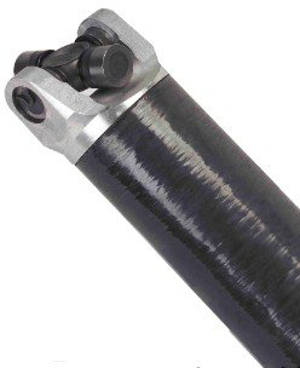
The drive shaft is under constant stresses and loads during everyday use and when you drive hard or are on the track, even more strain is put on the component. By upgrading this device with more exotic materials like Carbon Fibre you can not only help transmit more power to the driven wheels but also reduce weight and increase strength.
Reducing transitional rotational loses and normally with big weight loses due to the construction with specialise materials. A more efficient and more durable set up, with help maximise any additional power in the Engine reaching the wheels.
Carbon fibre can offers you more strength to resist extreme torque than steel with about half the weight. Just like the common use of lightweight materials for clutch and flywheel units, a lightweight drive shaft allows more of you engine's power to be applied to the wheels. Carbon fibre's unique vibration dampening characteristics also help improve power output.
All drive shafts twist to some degree when torque is applied through them and by upgrading the materials used, you get a more performance focused design. The advantage of a lower spring rate is less drive shaft shock throughout the Rev range and a reduction of stress on other drive line components. Also increased traction of the components.
Continual twist occurs when torque is applied to the device and this eventually causes metal construction shafts to set in a twisted position. Consequently the shaft ends become permanently out of line by several degrees and vibration begins to break components, due to the misalignment and high loads the components undergo. Carbon fibre, whoever has a near perfect "elastic memory" and resets itself after the twisting motion, which minimise the chance of failure.
Also another advantage is that if or when the unit is damaged, in normal metal construction. The metal broken end of the drive shaft essentially turns into a flailing ball and chain. Which will continue to cause damage to the under-body and other components. With Carbon fibre, the drive shaft will shatter into small piece, reducing further damage and potential injury.
Short Shifter
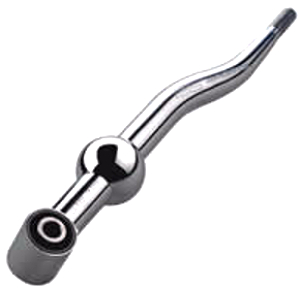
Essentially a device which reduces the length of the gear lever for manual gearboxes, this device results in quicker gear shift times. While this may be 0.2 or 0.3 of a second per shift, it may not sound like much, but over a course of a race you could make hundreds of gear changes, so the grand total of time saved, will soon add up. Even in drag racing applications or 0-60 time sprints, using this simple modification can gain good improvements over standard equipment.
A point to bear in mind is the need for accurate and precise gear changes though, as short shifters will need more skill to operate effectively. In heated racing environments a missed change will cost you more then the few tenths you just saved getting up to speed- worse case situation grinding gears and possible damage could result.